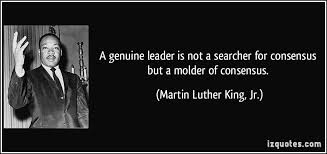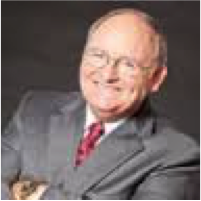 The Act of “Consensus” – Part II
The Act of “Consensus” – Part II
 “Consensus isn’t just about agreement. It’s about changing things around: You get a proposal, you work something out, people foresee problems, you do creative synthesis. At the end of it, you come up with something that everyone thinks is okay. Most people like it, and nobody hates it.”― David Graeber
“Consensus isn’t just about agreement. It’s about changing things around: You get a proposal, you work something out, people foresee problems, you do creative synthesis. At the end of it, you come up with something that everyone thinks is okay. Most people like it, and nobody hates it.”― David Graeber
 “Effective strategic leaders know how to get everyone involved in policy making and build consensus in the process. Within large complex organizations, whether public or private, consensus is the engine that sustains policy decisions. No strategic leader can succeed unless he or she can build such consensus. Thus, the search for consensus among peers, allies, and even competitors becomes a requirement for shared commitment to a national policy, and to corporate, business policy.” ― From National Defense University’s Website (http://www.au.af.mil/au/awc/awcgate/ndu/strat-ldr-dm/pt3ch11.html) – paper: “Strategic Leadership and Decision Making 11”
“Effective strategic leaders know how to get everyone involved in policy making and build consensus in the process. Within large complex organizations, whether public or private, consensus is the engine that sustains policy decisions. No strategic leader can succeed unless he or she can build such consensus. Thus, the search for consensus among peers, allies, and even competitors becomes a requirement for shared commitment to a national policy, and to corporate, business policy.” ― From National Defense University’s Website (http://www.au.af.mil/au/awc/awcgate/ndu/strat-ldr-dm/pt3ch11.html) – paper: “Strategic Leadership and Decision Making 11”
 “Someone has postulated that most human beings only use ten percent of their brain. If that is true, then ten people have to be in a meeting to get whole-brain thinking. This explains the value of working in teams.
“Someone has postulated that most human beings only use ten percent of their brain. If that is true, then ten people have to be in a meeting to get whole-brain thinking. This explains the value of working in teams.
Everyone who has been in one of my management training sessions knows that I define a "team" as a group of individuals who "step forward together" to achieve a common goal. Teamwork requires individuals to pool information and consider different viewpoints to find solutions and make decisions. Seldom do all team members have the same view about an idea or issue. Polarized views, opposing opinions, and stubborn holdouts can often block the progress of a team. The success of a team relies heavily on how quickly the members can come to consensus on both what their goal is and how it will be achieved.
A significant portion of a team's effectiveness and "health" is tied to how well the team members interact and make decisions…..
Coming to true consensus among a group of individuals is hard to do. It takes great facilitative skills and effective process tools among the group to bring everyone to agreement. True consensus requires everyone to remain firmly grounded and completely committed to their consensus decision once the team discussion has ended.
Unfortunately, I've found that consensus in many companies is only consensus until everyone leaves the room. Once people get back into their work area or start to ponder the team's decision outside the team room, some members tend to question the team's decision and their commitment to it. The key, therefore, to achieving consensus is not just getting it, but also making sure it sticks once it is reached.” ― Mac McIntire, President, Innovative Management Group (On website: http://www.imglv.com/articles/gaintrueconsensus.htm)
 “So what was the New Testament pattern for decision-making in the early church? It was simply by consensus. "Then it seemed good to the apostles and the elders, with the whole church," and, "it seemed good to us, having become of one mind." was the divine model for making corporate decisions (Acts 15:22, 25 NASB). In other words, the decision-making of the early church was not in the hands of the elders. It was in the hands of all the brothers and sisters. “― Frank Viola; “Reimaging Church”
“So what was the New Testament pattern for decision-making in the early church? It was simply by consensus. "Then it seemed good to the apostles and the elders, with the whole church," and, "it seemed good to us, having become of one mind." was the divine model for making corporate decisions (Acts 15:22, 25 NASB). In other words, the decision-making of the early church was not in the hands of the elders. It was in the hands of all the brothers and sisters. “― Frank Viola; “Reimaging Church”
 “It is important to remember that the process a church goes through in achieving consensus may be just as important as the consensus that is finally achieved. Consensus governing takes time, commitment, mutual-edification, and lots of brotherly love. It truly can work in smaller churches, such as were found in the New Testament era. We must love each other enough to put up with each other. The concept behind consensus might be called government by unity, oneness, harmony, or mutual agreement. Do we really trust in the Holy Spirit to work in our lives and churches?” “― Steve Atkerson; “Building Congregational Consensus”
“It is important to remember that the process a church goes through in achieving consensus may be just as important as the consensus that is finally achieved. Consensus governing takes time, commitment, mutual-edification, and lots of brotherly love. It truly can work in smaller churches, such as were found in the New Testament era. We must love each other enough to put up with each other. The concept behind consensus might be called government by unity, oneness, harmony, or mutual agreement. Do we really trust in the Holy Spirit to work in our lives and churches?” “― Steve Atkerson; “Building Congregational Consensus”